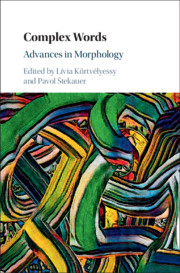Book contents
- Complex Words
- Complex Words
- Copyright page
- Dedication
- Contents
- Contributors
- Introduction: Advances in Morphology
- Part I Lexico-Semantic Aspects of Complex Words
- Part II Structure of Complex Words
- 7 Estonian Case Inflection Made Simple
- 8 Uninflectedness
- 9 Complex Exponents
- 10 Derivational Patterns in Proto-Basque Word Structure
- 11 The Complexity of Greek Verbal Morphology
- 12 Affixoids
- Part III Corpus-Based Case Studies
- Index
- References
12 - Affixoids
An Intriguing Intermediate Category
from Part II - Structure of Complex Words
Published online by Cambridge University Press: 18 September 2020
- Complex Words
- Complex Words
- Copyright page
- Dedication
- Contents
- Contributors
- Introduction: Advances in Morphology
- Part I Lexico-Semantic Aspects of Complex Words
- Part II Structure of Complex Words
- 7 Estonian Case Inflection Made Simple
- 8 Uninflectedness
- 9 Complex Exponents
- 10 Derivational Patterns in Proto-Basque Word Structure
- 11 The Complexity of Greek Verbal Morphology
- 12 Affixoids
- Part III Corpus-Based Case Studies
- Index
- References
Summary
This article investigates the presence of intermediate morphological categories between stems and affixes, the so-called affixoids (prefixoids and suffixoids) in a number of Modern Greek varieties. It argues that affixoids can exist as an independent morphological category in morphologically rich languages, such as Modern Greek, on the condition that these languages base their word-formation processes on stems. It also shows that affixoids can vary within the same language, depending on several factors, such as the original items the affixoids come from (Greek affixoids may emerge from lexemes or affixes), the word-formation process which gives birth to them, or the occurrence of a grammaticalization or a degrammaticalization process. Proposals and arguments are supported by evidence consisting of two prefixoids, plako- and mata-, and one suffixoid, -opulo, drawn from the Modern Greek varieties.
- Type
- Chapter
- Information
- Complex WordsAdvances in Morphology, pp. 217 - 238Publisher: Cambridge University PressPrint publication year: 2020



